#004
Statistics, which can be
applied to many fields
including sports analytics
Tomoyuki Furutani
Japanese Color: HANAASAGI-iro
#004
Tomoyuki Furutani
Japanese Color: HANAASAGI-iro
MOVIE

Professor
Faculty of Policy Management
The arrival of an Internet society with an advanced level of informatization has enabled the utilization of big data and open data in the present day.
Data science (applied statistics) is taking great leaps forward as an academic field through the emergence of massive data and new theories.
Its potential is not limited to the world of academia, but spreads to cover sectors such as sports, business, disaster prevention, and social security policy.
Professor Tomoyuki Furutani stresses that these data science trends have the power to revolutionize society itself.
My field of specialty is applied statistics, which has become widely known among the general public as the term “data science” in recent years. Data science is an academic field with the aim of applying collected and analyzed data to decision-making processes based on evidence. With the arrival of the Internet society, it has become possible to utilize unprecedented massive and complicated collections of data known as “big data.” It has also become possible to utilize data held by public offices and corporations in the form of open data. As a result, data science is becoming even more familiar and accessible to society.
On the other hand, data analysis methods have undergone innovative changes as we stepped into the 21st century, making it a major turning point for data science. One of these is Bayesian statistics, a method that involves capturing the empirical value arising as a consequence of factors as a probability, and calculating the probability of obtaining the same result when other factors occur. The second is spatio-temporal statistics, which uses data related to space and time to predict statistical trends and future.
Until the 20th century, the study of statistics was an academic field that involved the skillful handling of limited data on an extremely small scale, and combining that with theoretical statistics, which involves conducting an analysis corresponding to the theories. However, data science in the 21st century is becoming a field that predicts the future based on massive data, which can possibly change business, sports, and social rules.
Among the research fields that deal with data science, sports analytics is the area that I would like to inject particular effort into in the future. Firstly, with regard to sporting events, I collect and analyze data, including information pertaining to the movements of athletes in the sports arena, analyze tactics that are more efficient for the team and individual as well as the performance efficiency, and provide athletes with feedback. Specific activities that I have undertaken so far include an analysis of Spain’s representative soccer team, and an analysis of the performance of professional Japanese tennis players.
The data collected and analyzed in sports analytics not only contributes to improving the performance of athletes and teams, but is also applied widely in the sports business. For example in the United States, in various sporting events such as baseball and football, when the team manager decides on the salary of athletes, the decision is based on analytical data of the athletes’ performance obtained through sports analytics.
Furthermore, sports analytics is also required to play the role of contributing to the expansion of the sports business by exploring the needs of fans and sponsors, through the collection and analysis of data.
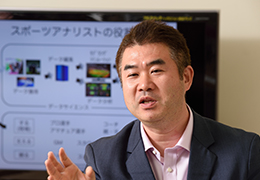
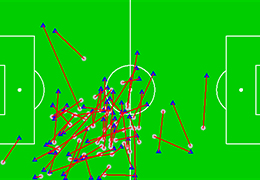
Sports analytics, which collects, analyzes, and predicts sports-related data and feeds it back to analysts, managers, and fans, have immense potential.
The research target for sports analytics is not limited to professional sports. In research in the field of amateur sports, I have approached groups such as the Keio University Athletic Association, and am involved in the development of athletes in the Rugby Football Club in cooperation with Keio Senior High School and Keio University.
Specifically, using video tracking systems, I record and collect event data, such as the position of athletes during training and competitions, and who made passes at which locations to which other players during a match. The results of the analysis are fedback to coaches and athletes.
In addition, I am also carrying out follow-up research as to how the performance of members of the club improves when they enter Keio University and join the Rugby Football club.
Overseas, the profession of sports analyst, who provides support for professional sports athletes and teams with sports analytics based on data science, has already been established mainly in countries such as the United States, Germany, Spain, and the United Kingdom. On the other hand, Japan has not yet reached the stage where sports analyst is regarded as an established profession. In the future, the development of sports analysts poses a significant challenge for Japan. I hope to play an active role in undertaking activities to establish SFC (Keio University Shonan Fujisawa Campus) as a hub for sports analysts.
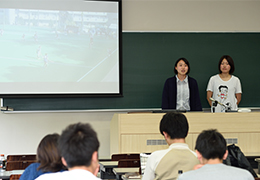
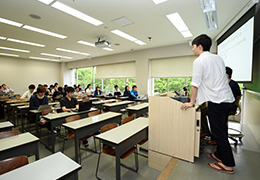
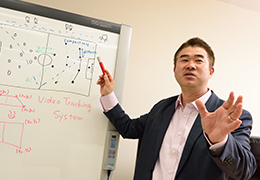
At Tomoyuki Furutani research laboratory, students practice data analysis methods and make presentations on the progress of their fieldwork. Most of the activities are conducted as group work, and importance is placed on communication between the students.
The Great East Japan Earthquake, which struck on 11 March 2011, created massive damage, and the situation of the nuclear accident at Fukushima Daiichi Nuclear Power Station has not been brought under control even today. My research laboratory is also engaged in the analysis of epidemiology and health data pertaining to this kind of serious disaster.
To date, with regard to the problem of radioactive contamination that arose after the nuclear accident at Fukushima Daiichi Nuclear Power Station, we have cooperated with hospitals and other organizations in Fukushima Prefecture to continuously conduct statistical analysis on research data on internal and external exposure to radiation. These include thyroid examination, whole body counter examination, and glass badge (personal dosimeter) examination.
We are also engaged in the spatial distribution analysis of soil radioactive contamination, and analysis of the relationship between ground radioactive contamination and radiation exposure. By mounting sensors on drones and launching them, this research collects, analyzes, and visualizes data on the contamination situation of locations that cannot be reached on foot, such as mountains and fields. This data is used in the creation of contamination maps. Studies on contamination conducted by national and local governments often make use of wide-area data. However, our studies and analysis visualize data that is more detailed, such as the situation of contamination for fields in front of civilian homes or hills behind houses. This allowed us to provide feedback based on this information to residents in the region.
The results of studies and analysis on nuclear accidents up to the fall of 2014 have already been published as a paper. Nevertheless, in the future, I aim to continue with this research over the long term as part of my life’s work.
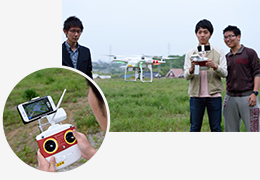
In the study of the situation of contamination in areas affected by the nuclear accident at Fukushima Nuclear Power Station, drones were used to take more refined measurements than measurements taken by people on foot or aircraft. A high-resolution, three-dimensional map was created.
The problem of declining birth rates and an aging population, as well as the corresponding rise in medical expenses, cannot be overlooked as problems that are common to developed countries, including Japan. In light of that, I am also involved in research relating to the medical and nursing care sector, which is my third area of research.
This involves making future predictions, through data science, on three key points: the per capital medical and nursing care costs in the region; the degree of sufficiency on the number of doctors and nursing care staff; and medical needs pertaining to diseases.
Based on results of studies and analysis conducted for the respective prefectures, future predictions of medical expenses show that medical expenses will increase to a certain degree if population decreases as a result of factors such as declining birth rates and an aging population, as well as depopulation. However, we predicted that medical expenses would stabilize once they have increased up to a certain level. Our analysis, combined with the results of existing research, is helping to reveal greater detail of such future predictions of medical expenses.
In addition, I am also interested in the theme of how far we can reduce medical expenses by developing public transportation in the region, such as railways.
Going forward, as new fields of sciences are being established, I believe that we will be able to provide a better perspective on our lives and society through the collaboration of these new fields with statistical studies. Hence, I am also setting my sights on research in that area.
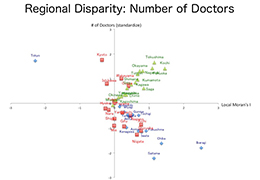
Data science methods throw light on regional disparity in medical expenses and the uneven distribution of professional medical staff in each region, which makes it possible to obtain information that is beneficial for the reform of the social security system, a pressing problem in Japan.

Tomoyuki Furutani
Professor, Faculty of Policy Management, Keio University. Completed doctoral program at the Department of Urban Engineering, Graduate School of Engineering, the University of Tokyo. Specializes in applied statistics, Bayesian statistics, spatial statistics, and data science. Target areas in data science cover a wide range, including homeland security, public health, medicine, health, sports, and mobility. Has authored many books, including Kuukan deta no toukei bunseki (The Statistical Analysis of Spatial Data), Kuukan deta to seisakugaku (Spatial Data and Policy Studies), and Beizu toukei deta bunseki (Analysis of Bayesian Statistical Data).
(Japanese Only)http://web.sfc.keio.ac.jp/~maunz/wiki/

2015.jul.ISSUE